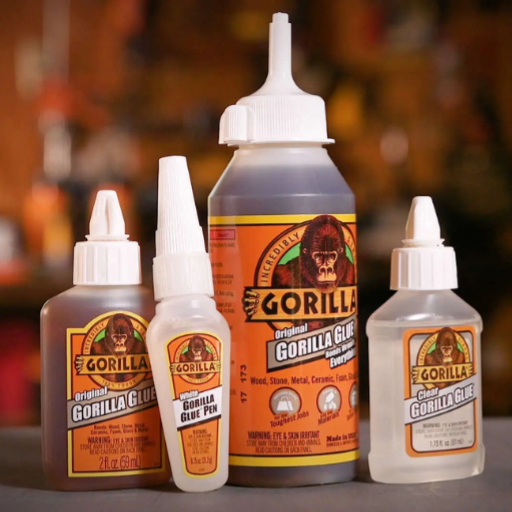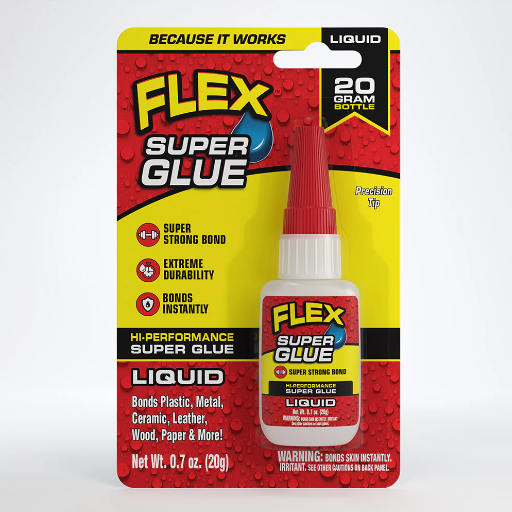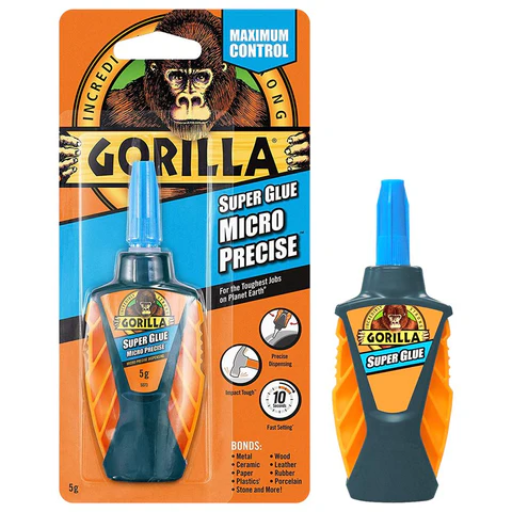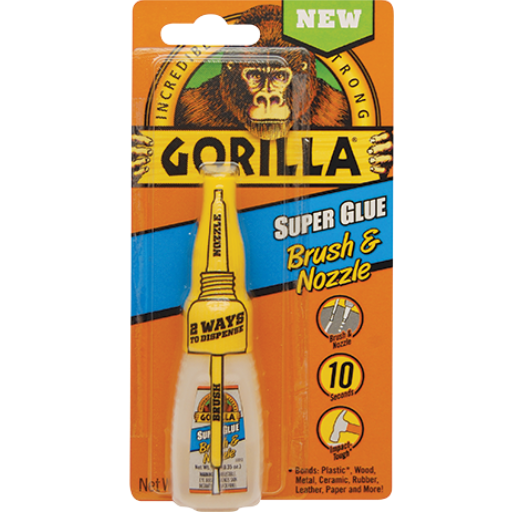Selecting the proper glue can greatly impact the result of your work, be it repairs, DIY projects, or inventing something new, sometimes even determining your success. Super Glue and Gorilla Glue are two of the most famous adhesives with exceptional binding adhesive properties, but which of the two is actually stronger? The focus of this article is to provide a deep analysis of these two adhesives, comparing their unique characteristics, advantages, and optimal applications. If you need an urgent solution or something tailored to your specific requirements—light or heavy duty—this guide will help you uncover all options quickly and grasp the answer you seek. Prepare to understand the principles of selection so you can determine which glue is the most suitable for your project!
What are the Differences Between Super Glue and Gorilla Glue?

Together with epoxy resin, Super Glue – also known as cyanoacrylate glue – forms a subgroup of adhesives referred to as instant adhesives because of the speed with which they bond materials together. Super Glue performs best with Glass, metal, and plastic, among other non-porous materials. It works best for precise, small repairs that need to be done fast. The other type of glue we are discussing here—Gorilla glue—is a polyurethane-based adhesive that expands while curing; it also activates by water. This characteristic makes it more effective on porous wood, foam, and some stones. The strongest downside of Super Glue is that it immediately bonds. On the other hand, it is easier to use for heavier duties because of its longer curing time—Gorilla Glue can do more in this aspect. The choice between the two will depend on the materials concerned and whether the need is for a quick or a sturdy adhesive solution.
Compare the differences between Super Glue and Gorilla Glue
|
Key Point |
Super Glue |
Gorilla Glue |
|---|---|---|
|
Base Ingredient |
Cyanoacrylate |
Polyurethane |
|
Activation |
Activates with moisture |
Activates with water |
|
Bonding Speed |
Bonds within seconds |
Takes 1-2 hours to cure |
|
Strength of Bond |
High tensile strength for small areas |
Extremely strong for large surfaces |
|
Usage with Porous Materials |
Less effective |
Highly effective |
|
Expansion During Curing |
No expansion |
Expands as it cures |
|
Water Resistance |
Limited |
Highly water-resistant |
|
Temperature Resistance |
Moderate |
High |
|
Best for Small Repairs |
Yes |
No |
|
Best for Heavy-Duty Use |
No |
Yes |
|
Application Surfaces |
Smooth and non-porous |
Porous or uneven |
|
Drying Time |
Instant bonding (seconds) |
Requires clamping while drying |
|
Shelf Life |
Short, prone to drying out |
Longer, durable when sealed properly |
|
Clean-up |
Acetone removable |
Requires sanding or scraping |
Common Uses for Each Type of Glue
Due to the speed at which it bonds, super glue is recommended in repairs that demand precision and detail, such as glass, metal, ceramics, and some plastics, which means smooth, nonporous materials abound. House items and in crafting as well as model building, all geared to explain the common application employed here is this rushing for instant bond feature is easy, strong united with pressure. Further proof of super glue’s versatility is its application in medicine by using it to seal small cuts. The weaknesses of super glue stem from an excessive lack of heat or water exposure—Steering clear of outdoor or heavy-duty tasks.
Utilized in industrial settings, epoxy adhesives are designed for enduring bonds that require high performance. They perform exceptionally well for structural repairs, assembly work, and restoration projects because they can bond with porous and uneven surfaces like wood, stone, or even concrete. They are also extensively applied in marine settings because of their excellent water resistance. Epoxies are favored in crafts and construction for filling gaps and repairing joints. Although epoxies need additional time and clamping during the curing phase, the unrivaled strength and durability they provide make them indispensable for professional tasks.
Which Glue Provides a Stronger Bond?

Epoxy glue usually has a better bond than adhesives for wood and other materials. It can bond metals, wood, ceramics, and even plastics with extreme strength because of its chemicals. Epoxy’s water, heat, and chemical resistance also makes it useful for heavy-duty functions. Other adhesives like cyanoacrylate work well for small and lighter jobs because of quick curing time. However, their bond strength and versatility have nothing compared with epoxy. Thus, epoxy helps in situations when an exceptionally strong bond is required.
What Factors Affect Adhesive Performance?
Other elements alongside the choice of adhesive impact adhesive performance, such as the use of temperature, humidity, and even the surrounding elements. Surface preparation is equally vital, as the adhesive faces tremendous backlash when interacting with dust, grease, and moisture, as they all form a protective covering barrier. To provide a clean surface and ensure perfect adhesion, scribing, chemical cleaning, among various other recognised techniques can be used.
Like many other forms of energy, sunlight can also affect temperature and ultraviolet light levels. Extreme hot or cold temperatures can cause certain adhesives to lose bond flexibility. Under certain conditions, some adhesives also lose moisture and flexibility. In addition, flexibility and moisture loss need to be monitored closely due to heat levels. Moisture cure adhesives can absorb moisture, but UV resistance is important for other uses where adhesive bonds are required.
Additives need to be compatible with the materials to satisfy the bonding requirements. Some additives are designed for specific materials such as metals, plastics and ceramics and require chemical or mechanical interactions. Wrong adhesives increase the risk of bond failure. Satisfying these conditions optimizes the wide scope of adaptability.
When to Choose Gorilla Glue for a Strong Fix
Using super strong water resistant glue filler is perfect option when looking for a durable, strong and versatile glue suitable for tough to handle projects. Best results are achieved when porous materials like wood, foam and fabrics and non porous materials such as metals, glasses and certain plastics are bonded together. It is also useful as it cures unevenly as it fills small gaps helping achieve a closer fit and stronger bond.
The adhesive gap filling properties also have their limitations, like lack of water resistance. This makes it easier to use both inside and outside as the glue can handle water and heat. Because of this, furniture can be repaired, cracks can be fixed, or even outdoor furniture can be made. These items are easy to maintain as the glue performs well under fluctuating temperatures. To achieve the full potential, gaining maximum bond strength requires proper measuring of the glue used. Proper clamping also achieves a high bond strength but ensures the gap does not widen because of uneven stretching.
How Do Drying Times Compare Between Super Glue and Gorilla Glue?

Super glue joins almost instantly and dries between 10 to 30 seconds which makes it perfect for repairs. Contrarily, Gorilla Glue takes longer to dry. It sets within 1-2 hours and takes about 24 hours to fully cure. The extended dry time does allow for some adjustments during the bond, but does require the use of clamps to hold the materials securely in place.
Typical Drying Times for Super Glue
In more technical terms, super glue is cyanoacrylate adhesive. It is famous for the speed at which it allows things to be glued together. Provided the conditions are slightly reasonable, super glue dries in 10 to 30 seconds now forming a strong glue layer that protects mechanical strength between multitude of different surfaces. Factors like the nature of the materials, humidity levels, and temperature affect the precise curing time. For instance, high humidity levels usually speed up the rate of bonding because cyanoacrylate reacts with moisture in the air, while lower humidity may slow the bonding period of time. Also, how much adhesive gets applied matters; thinner bonds dry more quickly, while excessive application can extend the time for bond formation.
Gorilla Glue’s Expansion and Drying Process
Gorilla Glue is well known because of its proprietary polyurethane formula. When added glue moisture from both the surrounding atmosphere and the surface triggers a chemical reaction turning glue into foam. During this foaming process which is exothermic in nature, glue achieves even better shoreline. The foaming process starts after 24-48 hours and depends on the environment. Forms like wood, stone or concrete are porous and are able to absorb glue which makes the bond even harder. Optimal results are always achieved at room temperature. Though too low or too high can cause negative impact on the efficiency of the curing process. During the application of polyurethane-based glue, care has to be taken to avoid using too much since this glue expands in volume.
Can You Use Super Glue and Gorilla Glue on Different Surfaces?

Both Super Glue and Gorilla Glue have their specific cases where they quite effective. Super Glue is very effective and works well with different types of materials such as glass, ceramics, metals, wood, and even plastics. Construction grade glues like the Gorilla Glue are great for wood joints, ceramics, stone and metal surfaces. But, take into account that construction grade glues require water to work properly. Both Super Glue and Gorilla Glue have their advantages and disadvantages, so always do research before using them on any type of surface.
Best Surfaces for Super Glue Application
Super glue and cyanoacrylate adhesive become known for their unique properties for being an all-in-one glues. Highly recognized in the market for having unique and multifunctional properties, super glue works great on various pairs of surfaces like ABS, PVC, metals, glass, ceramics and even some plastics. Small repairs for electronic devices, jewelry, household items or anything in need of precision make use of this highly durable glue.
How to Prepare Surfaces for Optimal Adhesion
Preparation of surfaces is perhaps the most important step in any adhesive application process since it determines the quality of adhesion. Start with surface cleansing using a disinfectant, for example, isopropyl alcohol, to eliminate any oil, grease, residue, or dirt. It is best to avoid water-based disinfectants since they can be counterproductive. For finer surfaces, a light sanding with fine sandpaper can be performed to better the texture to improve grip. Following this, the surface will need to be cleaned once again to eliminate any particulate debris. Other factors such as the environment also play a critical role; make sure the application site’s temperature and humidity is not outside the lower and upper thresholds specified by the adhesive manufacturer as this could weaken the bond. For specialty materials like plastics and metals, check if a surface-specific primer is needed. Strengthening the adhesion for long-term durability is not achievable without these steps.
What Are the Best Practices for Using Gorilla Glue and Super Glue?

- Surface Preparation: Ensure all dust, oils, and grease are removed voids. As well as surfaces being dry, perform light sanding to enhance the smooth bonding surfaces.
- Application:
- Gorilla Glue requires that one surface is dampened and another surface has a small amount applied to it. This glue activates when moisture is present.
- Super Glue should be used with caution, applying a drop to one surface only. Over application weakens bonds and is not advisable.
- Alignment: Join the surfaces you wish to glue together as soon as possible. Ensure they are aligned properly since glues like Super Glue bond very quickly and provide minimal adjustment flexibility.
- Clamping (if needed):
- Due to the expansion properties of Gorilla Glue, it is advisable to apply clamping or pressure for 1 to 2 hours.
- Hold the joint with gentle pressure for a few seconds until set, and no clamps are needed with Super Glue.
- Curing Time: Always follow the manufacturer’s instructions for curing. Most Super Glues cure fully within 24 hours but set within seconds. Gorilla Glue usually takes around 24 hours and would still require around 1 hour to set.
- Storage: Both adhesives should be kept in a dry, cool place. After using, the container should be sealed tightly to prevent it from drying.
Adhering to the above procedures will enhance your bond strengths, make your adhesive application last longer, and make your restorations more reliable.
Tips for Applying Super Glue Effectively
- Clean the Surfaces Thoroughly: Use isopropyl alcohol or any stronger solvent to clean surfaces that require bonding.
- Use the Right Amount: One drop of super glue is recommended for one square inch, as the excess portion can weaken the resulting bond.
- Apply Even Pressure: Apply consistent force for 10 to 30 seconds after the surfaces are bonded. Uniform pressure helps with the uniform distribution of the adhesive for better bond strength.
- Allow Proper Curing Time: Super glue can bond in seconds, but it takes 24 hours to cure fully. Do not stress the joint during this period to increase the bond durability.
- Consider Environmental Factors: An ideal environment for super glue is 50°F to 90°F (temperature), 40% to 70% (relative humidity). Outside these ranges the glue’s performance is compromised.
How to Clean Up Excess Adhesive
Excess adhesive needs to be meticulously managed when cleaning up to ensure that the surface maintains a polished look. It is easier to deal with dried superglue as compared to wet adhesive. Remove residue from non-porous surfaces using a sharp tool like a razor blade or a scraper. For more delicate surfaces and porous materials, it is better to use a small amount of nail polish remover, acetone, cyanoacrylates, the main ingredient in super glue, which dissolves in acetone. Make sure to try acetone first on a hidden area of the material to see if it would cause any damage. Safe surfaces can use warm, soapy water and white vinegar for spot cleaning and are less likely to damage material. Remove materials from sink and dispose of them responsibly as discarding them directly into the drain would cause contamination.
Reference Sources
- Superglue – an overview – Discusses cyanoacrylate-based adhesives, their uses, and applications.
- Why is super glue so strong? | HowStuffWorks – Explains the science behind super glue’s strength and how it bonds to surfaces.
- Super Glue: Unveiling the Secrets of Its Quick Bonding – Details the polymerization process and the science behind super glue’s quick bonding.
Frequently Asked Questions (FAQs)
Q: What are the main pros and cons of super glue?
A: Super glue, such as Loctite super glue or Krazy glue, bonds quickly and offers a strong hold for small repairs. However, it can be brittle and is not suitable for flexible joints. It’s best for quick fixes but may not withstand significant stress.
Q: How does Gorilla Glue compare to super glue?
A: Gorilla Glue is a polyurethane adhesive that expands as it dries, providing a strong bond, especially for porous materials like wood. In contrast, super glue dries fast and is ideal for non-porous surfaces. The choice depends on the specific materials you’re working with.
Q: When should I use wood glue instead of super glue?
A: Wood glue is specifically designed for joining wood and provides a strong bond that can flex with the material. Use wood glue if you’re doing joinery or working with wooden surfaces, while super glue is better for quick fixes on non-wood materials.
Q: What is the best choice for ceramic repairs, super glue or Gorilla Glue?
A: Super glue is often the best choice for ceramic repairs because it bonds quickly and dries clear. Gorilla Glue can work as well, but it expands and can create a mess if not applied carefully. Always ensure the surfaces are clean before applying the glue.
Q: Can super glue be used for outdoor projects?
A: While super glue can be used outdoors, it is not the most durable option in extreme weather conditions. Gorilla Glue is a better choice for outdoor projects as it is more resilient to moisture and temperature changes.
Q: How do I know which adhesive is best for my project?
A: Choosing the right glue depends on the materials you are bonding and the conditions they will face. Consider factors like flexibility, strength, and exposure to moisture. Reviewing the pros and cons of each adhesive will help you make an informed decision.
Q: Is Gorilla Super Glue better than other types of adhesives?
A: Gorilla Super Glue is an excellent choice for many quick fixes due to its strong bond and fast drying time. However, the best choice depends on what you are bonding; for instance, wood glue may be better for woodworking projects.
Q: What should I consider when applying super glue?
A: When applying super glue, make sure the surfaces are clean and dry. Apply the glue in a thin layer and hold the pieces together for a few seconds to ensure a strong bond. Be cautious as super glue can bond skin quickly.
Q: How long does it take for Gorilla Glue to dry?
A: Gorilla Glue typically takes about 1-2 hours to set and can take up to 24 hours to fully cure. It is crucial to clamp the pieces together during the drying process to achieve the best bond.



















